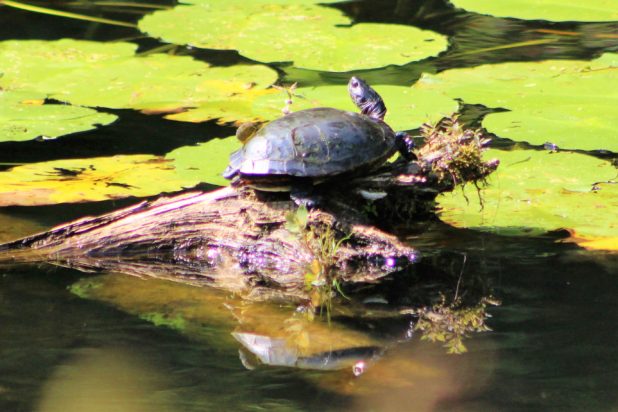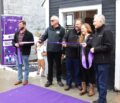Commentary
The McBride project: To be, or not to be
August 28, 2018

August 28, 2018
By Nate Smelle
WITH any proposed development, the first step towards acceptance or rejection is always asking questions. Since learning of Pancon’s McBride project last week from Limerick resident Monica Nikopoulos, I’ve spent a great deal of time doing just that.
Discovering that the mining project was less than 20 minutes away from my home, I jumped in the car to take a short trip south on Hwy 62 to drive the perimeter of the drilling area. Without any details on the project other than its basic location, I began stage one of my investigation by surveying the roadside along Hwy 620 from Hwy 62 to Ormsby. Just before I turned left onto Old Hastings Road – the western boundary of the drilling area – I had to pull over on the shoulder to help a painted turtle that was taking its sweet time crossing the highway.
Now travelling east on Old Hastings Road, I slowed to a crawl to carefully observe the picturesque landscape lining the road on both sides. The resident ecosystem where Pancon soon plans to resume drilling is composed of a mix of forests, ponds and wetlands – each hubs of biodiversity in their own right. The area is also home to many people who live there year-round or seasonally.
Keeping track of how many homes, cottages and driveways there were on this scenic route, I lost track when I nearly ran over a milk snake basking in the sun on the gravel. Slamming on the brakes, I backed up and pulled over again and decided to get out of my car and carry on by foot. While the snake slithered out of sight before I could take a photo, it turned out to be a successful day behind the lens. By the time I arrived at Yvonne’s Pond – a body of water within the McBride projects area of exploration – I captured images of a white-tailed buck, a Blanding’s turtle, a great blue heron and several different types of dragonflies, butterflies and frogs.
Walking back to my car after relaxing by the pond, I pondered how a nickel, copper and cobalt mine would impact the area and the type of experience I had enjoyed on this day.
Back behind the wheel, I continued driving the boundaries of the McBride Project, turning left on North Steenburg Lake Road at Murphy’s Corners. Yet again I was compelled to pull over by my surroundings when I spotted a few common mergansers feasting away along the shorelines of Steenburg Lake. Hopping back into my car, I kept driving until I reached Hwy 62. Turning left again, I completed my first circumnavigation of the McBride project and headed for home.
Speaking with Nikopoulos and Canadian program coordinator at Mining Watch Ugo Lapointe the next morning, I realized that each of their concerns seemed to be centred on how a mining project would impact the surface water and the groundwater filtering through the wetlands I had explored a day earlier. Having worked in the industry for several years, Lapointe said that he has not heard of a single mining project in Canada in the past decade that did not result in water pollution. The big question on his mind, he said, is whether the McBride project is the right type of development for North Hastings.
Later that afternoon I had a chance to learn firsthand about what the McBride project entailed, while sitting down at a picnic table outside the Old Hastings Gallery in Ormsby with Pancon’s president/CEO Layton Croft, the project’s lead geologist Derek McBride and Jeanny So from the company’s investor relations department.
At the start of our conversation, Croft immediately corrected me when I asked him about the potential environmental impact of mine in the area, indicating that the McBride project was not a mine, but a mining exploration project. Pressing forward with my line of questioning about Pancon’s intentions, he said that if their explorations were successful, the goal would be to get those resources to market. Croft also acknowledged that the drilling done by Macassa Gold Mines Ltd, Long Lac Minerals Ltd and Limerick Mines Ltd between the 1960s and 2004 determined that there was approximately 5.1 million tons of nickel, copper and cobalt within the drilling area’s main mineralization site. Though the McBride project is indeed still in its exploratory stage, this to me at least confirmed that their explorations would most likely be successful. Considering these resources would need to get to market, a mine would therefore be the inevitable outcome of the McBride project.
Seeming to sense my skepticism, Croft told me that Pancon takes environmental issues seriously, explaining how they planned to conduct an environmental baseline study throughout the drilling area. Asking how such a development would affect the surface water and groundwater flow, McBride filled me in on the company’s understanding of the drainage in the area. According to McBride a study by Limerick Mines Ltd, started but not finished in 2004, revealed that the flow of water in the drilling area did not flow into Steenburg Lake as I had previously heard. Instead, he explained that it flowed from Phillips Marsh down Nicholson Creek and eventually into Dickey Lake.
Speaking to how a mine would benefit the local economy, Croft and McBride stressed that if their exploration paid off it could bring jobs to the area, providing both a direct and indirect economic impact. While this may be true, the question I found myself mulling over on the ride home this time, was how the McBride project would affect the local tourism industry and real estate market. Both good questions to put forward at Pancon’s public meeting on Sunday, Sept. 9 at the Limerick Community Centre. The meeting starts at 4 p.m. but you may want to get there early to get a seat since I’m pretty sure I’m not the only one with questions.


















